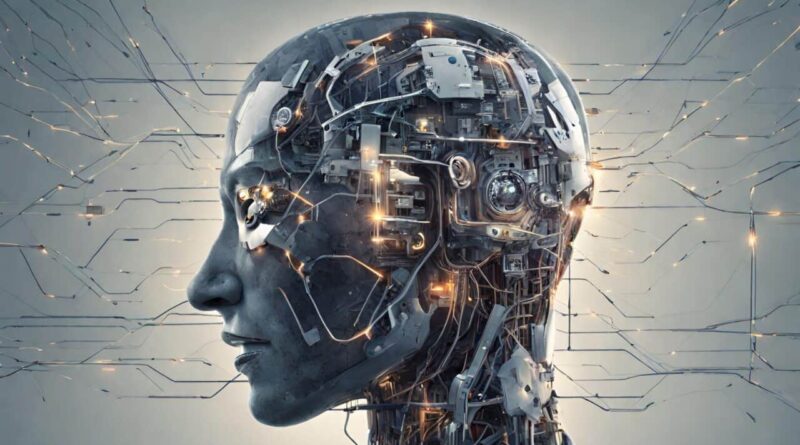Artificial Intelligence (AI) and Machine Learning — The Future of Intelligent Technology
Introduction to Artificial Intelligence (AI)
Artificial Intelligence (AI) is a branch of computer science that enables machines to think, learn, and make decisions like humans. The goal of AI is to create systems that can perform tasks that usually require human intelligence, such as understanding language, recognizing patterns, solving problems, and making predictions.
AI mimics the way humans think and learn, using algorithms and data to simulate reasoning and creativity. From virtual assistants like Siri and Alexa to self-driving cars, AI is changing how we live and work.
History and Evolution of AI
The concept of intelligent machines began in the 1950s when scientists like Alan Turing, John McCarthy, and Marvin Minsky laid the foundations of AI.
In 1956, the term “Artificial Intelligence” was officially introduced at the Dartmouth Conference.
The 1960s–1980s saw the creation of early AI programs that could play chess or solve logic puzzles.
In the 1990s, AI systems became more practical — IBM’s Deep Blue famously defeated world chess champion Garry Kasparov.
Today, with the rise of Big Data, Machine Learning, and Deep Learning, AI has become more powerful, accurate, and integrated into everyday life.
Types of Artificial Intelligence
AI can be divided into three main categories based on its capabilities:
Narrow AI (Weak AI):
Designed for specific tasks.
Examples: Voice assistants, spam filters, recommendation systems.
General AI (Strong AI):
Can understand, learn, and apply intelligence across different fields — just like humans.
Still under research and not yet achieved.
Super AI:
A futuristic concept where machines surpass human intelligence in every aspect — creativity, logic, and emotion.
Currently only theoretical, but it raises ethical and safety concerns.
What is Machine Learning (ML)?
Machine Learning (ML) is a subset of AI that enables computers to learn automatically from data without being explicitly programmed.
Instead of following fixed instructions, ML systems use data to identify patterns, make predictions, and improve over time.
For example, an ML algorithm can learn to recognize cats in photos after analyzing thousands of labeled cat images. The more data it gets, the more accurate it becomes.
Types of Machine Learning
Machine Learning is mainly classified into three types:
Supervised Learning:
The algorithm is trained using labeled data (where the correct answers are known).
Example: Predicting house prices from known data.
Unsupervised Learning:
The algorithm finds hidden patterns in unlabeled data.
Example: Grouping customers based on purchasing behavior.
Reinforcement Learning:
The system learns by trial and error, receiving rewards or penalties.
Example: Teaching robots to walk or play games like chess.
Deep Learning and Neural Networks
Deep Learning is an advanced form of Machine Learning that uses Artificial Neural Networks — systems inspired by the human brain.
Neural networks consist of layers of interconnected nodes (neurons) that process data and extract complex patterns.
Deep learning powers many modern AI applications, such as facial recognition, self-driving cars, voice translation, and medical image analysis. Its ability to handle massive datasets has made it one of the most powerful tools in technology today.
Natural Language Processing (NLP)
Natural Language Processing (NLP) is a branch of AI that helps computers understand, interpret, and generate human language.
It’s what allows chatbots, translators, and AI models like ChatGPT to communicate naturally with people.
Applications include:
Speech recognition (e.g., Google Assistant, Siri)
Language translation (e.g., Google Translate)
Text summarization and sentiment analysis
NLP bridges the gap between humans and machines, making digital communication smoother and more intuitive.
Computer Vision
Computer Vision enables computers to “see” and understand the visual world. By analyzing images and videos, AI systems can identify objects, faces, gestures, and movements.
Examples include:
Facial recognition in smartphones
Medical image diagnosis
Traffic monitoring and self-driving vehicles
Through deep learning, computer vision systems have become as accurate as — and sometimes even more accurate than — the human eye.
AI in Robotics
When AI is combined with robotics, machines gain the ability to move, interact, and make decisions autonomously.
Industrial Robots: Used in factories for precision manufacturing.
Service Robots: Used in healthcare, cleaning, and delivery.
Humanoid Robots: Designed to mimic human behavior, like Sophia.
Drones: AI-powered drones can navigate and make real-time decisions during flight.
This combination of AI and robotics is driving automation across multiple sectors.
AI in Daily Life
AI has quietly become a part of our everyday lives. Examples include:
Virtual Assistants: Siri, Alexa, and Google Assistant help with daily tasks.
Recommendation Systems: Netflix, YouTube, and Amazon suggest content or products you may like.
Smart Devices: AI controls thermostats, cameras, and home security systems.
Navigation Apps: Google Maps uses AI to find the best routes and predict traffic.
Whether we realize it or not, AI makes daily life simpler, smarter, and more personalized.
AI in Business and Industry
Businesses around the world use AI to increase efficiency and improve customer experiences.
Finance: Fraud detection, risk analysis, and algorithmic trading.
Healthcare: Disease prediction, personalized medicine, and robotic surgeries.
Education: AI tutors, grading systems, and adaptive learning platforms.
Manufacturing: Predictive maintenance and quality control.
AI helps industries reduce costs, improve accuracy, and make faster decisions — driving digital transformation across all sectors.
Ethical Issues and Challenges in AI
With great power comes great responsibility. AI development raises serious ethical and social challenges, such as:
Data Privacy: Protecting personal information used by AI systems.
Job Loss: Automation replacing human workers in certain roles.
Algorithmic Bias: AI making unfair decisions due to biased training data.
Accountability: Determining who is responsible when AI makes mistakes.
Ensuring responsible and ethical AI is vital to building trust and preventing misuse of technology.
AI Tools and Programming Frameworks
Developers use specialized tools and frameworks to build AI and ML applications.
Some of the most popular include:
TensorFlow: Google’s open-source platform for deep learning.
PyTorch: Preferred for research and prototyping.
Scikit-learn: Great for traditional ML algorithms.
Keras: Simplifies building and training neural networks.
These frameworks make AI development faster, more efficient, and widely accessible.
Future Trends in AI and Machine Learning
The future of AI is full of exciting innovations:
Generative AI: Systems that can create text, music, art, and even videos (e.g., ChatGPT, DALL·E).
Quantum AI: Combining AI with quantum computing for unmatched processing power.
Autonomous Systems: Self-driving cars, drones, and robots that operate independently.
Explainable AI: Making AI decisions more transparent and understandable.
As technology evolves, AI will continue to expand into every field — from medicine to space exploration.
The Future Impact of AI on Society
AI and Machine Learning will redefine how humans interact with technology. They will improve healthcare, education, transportation, and communication while also creating new job roles that focus on creativity and innovation.
However, it’s important to balance progress with ethics, ensuring that AI remains fair, transparent, and human-centered. If used wisely, AI can lead humanity into a smarter, more connected, and sustainable future.
Conclusion
Artificial Intelligence and Machine Learning are more than just technologies — they are revolutionary forces shaping the future of human civilization. From automating tasks to solving global challenges, AI has become an integral part of modern life.
As we continue to explore and develop AI responsibly, it will open doors to endless possibilities — helping us build a future where humans and intelligent machines work together for a better world.

